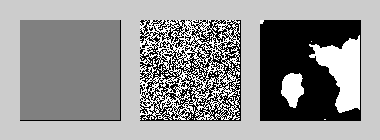Entropy & Motion Graphics
Claude Shannon’s Information Theory tells us that any given communications channel has limited capacity or bandwidth. There is a fixed amount of information (measured as entropy or non-repetition) that can be passed thru that channel without introducing errors.
Human perception can be viewed as a communications channel, also posessing limited bandwidth.
When faced with too much new information, humans will stop processing it. The principal symptom is boredom:
erroneously assuming that the new information isn’t actually new and lumping it in with
information that has been received before: it is “all the same”. Paradoxically, this feels very much like
the boredom we experience when receiving no information at all.

The first image, which contains all pixels of one color, contains too little information – it is boring.
The second image, which contains randomly colored pixels, contains too much information – it is also boring.
The third image also contains randomly colored pixels, but there is a high correlation from one pixel to the next.
There means there is less information in the image, and this makes the image more understandable, and (although
still somewhat boring) I believe it less boring than the first two.
Jackson Pollock paintings, in my view, contain too much information, and can also be boring. They can be made
more interesting, by looking at details of them up close, thus reducing the information content.
When designing motion graphics for a screensaver, I try to take this into account. I view an animation
as delivering change (entropy) over time. The amount of new information that can be transmitted over time
must be carefully modulated. If too little information is transmitted, the user gets bored. If too much
information is transmitted, the user also, paradoxically, gets bored. The sensation of change, when
delivered in discrete steps, interleaved with non-change can be very pleasant. Too much change, however,
tires the viewer.
I find some movies, which fill the screen with information, tiring on first viewing. A good example is
“Nightmare before Christmas”. I enjoyed this movie much more on subsequent viewings: having
seen it before, I found it easier to process the new information.
I also have had this experience with some complex music.
The Boundary
My favorite media experiences tend to deliver nearly as much information as I can handle, maybe a little more, maybe
a little less – but very close to the boundary. Sometimes I will need to see the movie (hear the music) a few times before I can reach that point.
One of the reasons that I think some people enjoy animated Mandalas and 2-mirror kaleidoscopes, is that they
combine new (essentially random) information with symmetric copies, which reduce the total amount of information
and make it easier to process. For the people who enjoy them, the information is delivered close to the boundary.
In a personal communication describing kaleidoscope content, Don Doak told me that the best kaleidoscope animations are “beyond the ability of the viewer to understand, but only just” – the viewer feels as if he is on the verge of understanding it,
as if a great truth is about to be revealed.
An expanded version of this essay can be found in the third issue of Mung Being.


August 11th, 2006 at 3:16 pm
I still create motion graphics using the Palace software and Iptscrae. It enables sequencing of JPEG`s, still a neat simple idea as JPEGS are small and easily adapted in just about every paint program freely available.
JASC Paint Shop Pro and Animation Shop are capable of some very convincing effects. You can see those ive created at Incony`s Palace both in the directory and some ideas i am looking at regarding 360 views.
Repetition is a very common occurrence in nature, it is inherrent in everything we do and see. I wish Jasc would update Animation Shop, even though i am so impressed at the thought that went into it., those who created it certainly knew what they were doing.